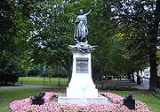
Highbury Fields
Encyclopedia

Highbury
- Early Highbury :The area now known as Islington was part of the larger manor of Tolentone, which is mentioned in the Domesday Book. Tolentone was owned by Ranulf brother of Ilger and included all the areas north and east of Canonbury and Holloway Road. The manor house was situated by what is now...
, in the London Borough of Islington
London Borough of Islington
The London Borough of Islington is a London borough in Inner London. It was formed in 1965 by merging the former metropolitan boroughs of Islington and Finsbury. The borough contains two Westminster parliamentary constituencies, Islington North and Islington South & Finsbury...
, England. At 11.75 hectares (29 acres), it is the largest open space in the borough.
It extends north from Highbury Corner almost as far as Highbury Barn. Besides parkland, Highbury Fields contains recreational facilities including tennis courts and Highbury Pool, which reopened after refurbishment in January 2007.
Georgian and Victorian terraces

Terraced house
In architecture and city planning, a terrace house, terrace, row house, linked house or townhouse is a style of medium-density housing that originated in Great Britain in the late 17th century, where a row of identical or mirror-image houses share side walls...
and are highly desirable residences. These terraces lie on three roads: Highbury Place, Highbury Crescent, and Highbury Terrace.
John Dawes bought much of the demesne and began the residential development of Highbury. He granted leases in 1774-9 for 39 houses on Highbury Place. These were designed and built by John Spiller, a speculative builder of Southwark. The terrace was completed in 1777. Famous residents include:
- 1. Walter SickertWalter SickertWalter Richard Sickert , born in Munich, Germany, was a painter who was a member of the Camden Town Group in London. He was an important influence on distinctively British styles of avant-garde art in the 20th century....
, the Impressionist painter, lived here and ran a rather unsuccessful school for artists at from 1927-31. - 22. This became the home of Charles, the character played by Hugh GrantHugh GrantHugh John Mungo Grant is an English actor and film producer. He has received a Golden Globe Award, a BAFTA, and an Honorary César. His films have earned more than $2.4 billion from 25 theatrical releases worldwide. Grant achieved international stardom after appearing in Richard Curtis's...
in Four weddings and a funeralFour Weddings and a FuneralFour Weddings and a Funeral is a 1994 British comedy film directed by Mike Newell. It was the first of several films by screenwriter Richard Curtis to feature Hugh Grant...
. - 25. John WesleyJohn WesleyJohn Wesley was a Church of England cleric and Christian theologian. Wesley is largely credited, along with his brother Charles Wesley, as founding the Methodist movement which began when he took to open-air preaching in a similar manner to George Whitefield...
stayed here. - 25. Joseph ChamberlainJoseph ChamberlainJoseph Chamberlain was an influential British politician and statesman. Unlike most major politicians of the time, he was a self-made businessman and had not attended Oxford or Cambridge University....
lived here from 1845-54. - 39. John Spiller moved in when the terrace was completed in 1777.
- ??. Abraham NewlandAbraham NewlandAbraham Newland was the chief cashier at the Bank of England from 1782 to 1807. The expression "an Abraham Newland" came to mean a bank note, because without his signature no Bank of England note was genuine....
, chief cashier of the Bank of England, never slept out of it for 25 years. His house on Highbury Place was for daytime use only.
The next major development around what was to become Highbury Fields was the construction of Highbury Terrace. The central part of the terrace dates to 1789. By 1794 nos. 1-16 had been built.
Highbury Crescent was begun in 1844, when land was laid out for it by James Wagstaff and James Goodbody. Nos. 19-25 were let to Goodbody in 1846. The houses were pairs of large Italianate villas, with rich and varied decorations in stucco.
War memorial
At the south end of the fields stands a war memorial dating from 1906, featuring a wreath, cannons and the captured standards of defeated enemies. It commemorates Islington residents who fell in the Boer WarSecond Boer War
The Second Boer War was fought from 11 October 1899 until 31 May 1902 between the British Empire and the Afrikaans-speaking Dutch settlers of two independent Boer republics, the South African Republic and the Orange Free State...
. Many consider it a fine example of art nouveau
Art Nouveau
Art Nouveau is an international philosophy and style of art, architecture and applied art—especially the decorative arts—that were most popular during 1890–1910. The name "Art Nouveau" is French for "new art"...
.

